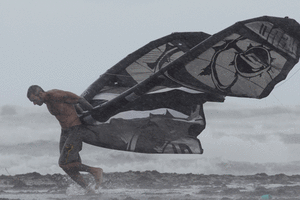Tropical Storm Alex is Hurricane Alex now
Tropical Storm Alex is now Hurricane Alex. Tropical Storm Alex became a hurricane shortly before 10 p.m. and is now churning up the waters toward Mexico and Texas

A kiteboarder struggles thru strong winds and a rain squall in Aransas Pass, Texas as the coast was hit by the first bands of Hurricane Alex on Tuesday afternoon. The Texas coastal bend prepared for Hurricane Alex, the first hurricane of the 2010 Atlantic season. It is predicted to make landfall approximately 10 miles south of Brownsville, Texas at noon on Wednesday, June 30, 2010
NEWSCOM
Brownsville, Texas
Hurricane Alex churned westward through the Gulf of Mexico early Wednesday, far from oil spill cleanup efforts but on a collision course with Mexico and the southern Texas coastline.
The National Hurricane Center in Miami upgraded the storm to a Category 1 hurricane — the least powerful type — shortly before 10 p.m. Tuesday after measuring sustained winds of 75 mph (121 kph). Alex became the first June hurricane in the Atlantic since 1995, the center said.
Texas residents had been preparing for the storm for days, readying their homes and businesses and stocking up on household essentials. But the storm was expected to deal only a glancing blow to the state and to make landfall Wednesday evening south of Matamoros, Mexico, and some 100 miles (160 kph) south of Brownsville.
The storm was expected to pack winds of at least 90 mph (145 kph) when it comes ashore, but wasn't expected to become one of the more powerful categories of hurricane.
As of 4 a.m. CDT Wednesday, Alex was 235 miles (378 kilometers) southeast of Brownsville moving west-northwest at about 7 mph (11 kph), with maximum sustained winds near 80 mph (129 kph).
Coastal residents and vacationers looking forward to the Fourth of July weekend began preparing in earnest Tuesday for the storm.
Oil rigs and platforms in the path of the storm's outer bands were evacuated, and President Barack Obama issued a pre-emptive federal disaster declaration for southern Texas counties late Tuesday.
The three oil rigs and 28 platforms evacuated are not part of the Gulf oil spill response. Alex is projected to stay far away from the spill zone and not effect recovery efforts, but tall waves kicked up by the farthest reaches of Alex did toss oil-soaking boom around the water.
Texas also watched Alex's outer bands warily. Alex was expected to bring torrential rains to a Rio Grande delta region that is ill suited — both economically and geographically — to handle it.
In Matamoros, cab driver Alfonso Lopez said he worried that that people would wait until the last minute to take the storm seriously.
"A lot of people trust too much that it won't be very bad or it will change course," he said.
In Cameron County, one of the poorest areas of the U.S. and Texas' southernmost point, Brownsville Mayor Pat Ahumada said he would wait to make his city's emergency declaration, in part because the city is cash strapped and he did not want to start paying city workers extra before absolutely necessary.
On nearby South Padre Island, the mood was less anxious. Although hotels and restaurants looked deserted compared with the crush of vacationers who normally pack the popular vacation spot in the summer, those who stuck around didn't size up Alex as much of a threat.
One couple renewed their wedding vows on the beach as a few campers rumbled their trailers — reluctantly — out of the park hours before a mandatory evacuation deadline.
"It's June. It's too soon for hurricanes," said Gloria Santos, of Edinburgh, after hitching her trailer back to her truck.
Jerry Wilson, 50, also didn't think much of Alex while struggling to hoist a painter's pole in fierce gusts. With a cloth rigged to the top of the pole, Wilson was cleaning his 10 cameras across the island that will let Internet viewers watch Alex's arrival live online.
"We got two generators and lots of guns and ammo, so we're not worried about it," Wilson said.
RELATED:
